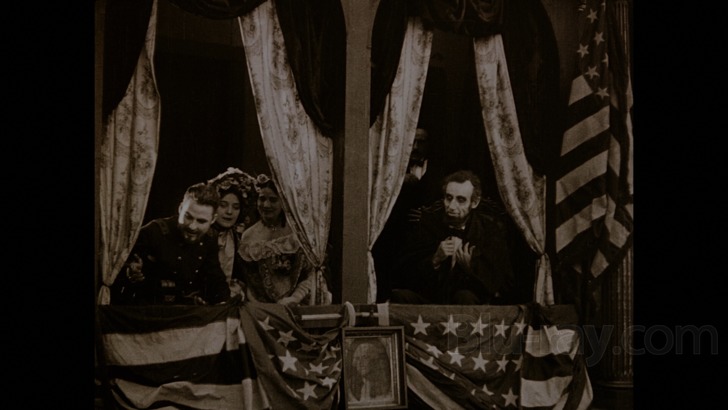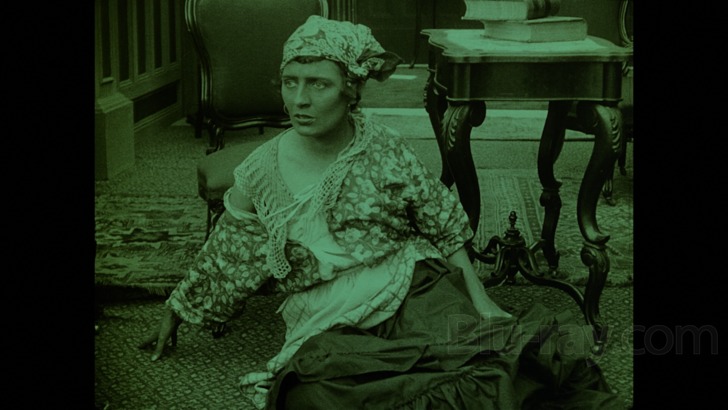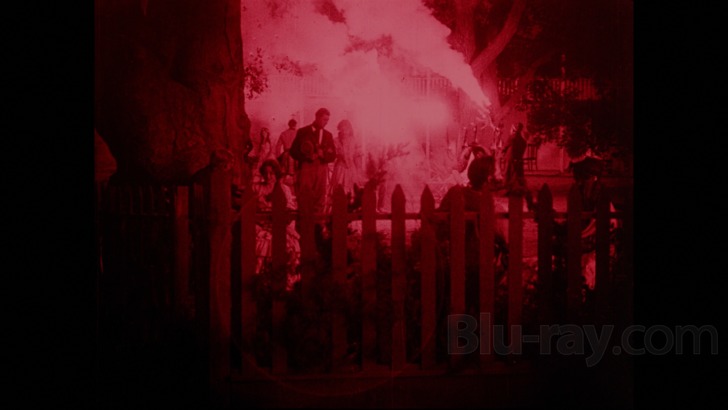The Birth of a Nation Blu-ray Movie
HomeThe Birth of a Nation Blu-ray Movie 
Limited Edition to 3000Twilight Time | 1915 | 186 min | Not rated | May 22, 2018
Movie rating
6.7 | / 10 |
Blu-ray rating
| Users | 0.0 | |
| Reviewer | 5.0 | |
| Overall | 5.0 |
Overview
The Birth of a Nation (1915)
Nearly 100 years after its initial release, The Birth of a Nation remains one of the most controversial films ever made and a landmark achievement in film history that continues to fascinate and enrage audiences. It is the epic story of two families, one northern and one southern, during and after the Civil War. D. W. Griffith's masterful direction combines brilliant battle scenes and tender romance with a vicious portrayal of African-Americans. It was the greatest feature-length blockbuster yet to be produced in the United States and the first to be shown in the White House. After seeing it, President Woodrow Wilson remarked it was "like writing history with lightning!"
Starring: Lillian Gish, Mae Marsh, Henry B. Walthall, Miriam Cooper, Mary AldenDirector: D.W. Griffith
| Drama | Uncertain |
| War | Uncertain |
| History | Uncertain |
| Epic | Uncertain |
Specifications
Video
Video codec: MPEG-4 AVC
Video resolution: 1080p
Aspect ratio: 1.32:1
Original aspect ratio: 1.33:1
Audio
Music: DTS-HD Master Audio 5.1 (48kHz, 24-bit)
Music: DTS-HD Master Audio 2.0 (48kHz, 24-bit)
Subtitles
None
Discs
Blu-ray Disc
Two-disc set (2 BDs)
Playback
Region free
Review
Rating summary
| Movie | 5.0 | |
| Video | 5.0 | |
| Audio | 5.0 | |
| Extras | 5.0 | |
| Overall | 5.0 |
The Birth of a Nation Blu-ray Movie Review
Song of the South?
Reviewed by Jeffrey Kauffman May 28, 2018George Santayana gave the world one of its more, well, memorable quotes when he stated, “Those who cannot remember the past are condemned to repeat it”. It’s a salient adage when approaching D.W. Griffith’s immensely contoversial film Birth of a Nation, but there are a number of other interesting thoughts from this philosopher which may also help to provide a bit of contextualizing insight into a film that is both lionized and despised in about equal measure. In terms of some of the more despicable depictions of race and supposedly nefarious (in Griffith’s formulation) “advancements” that took place during the Reconstruction period, one might refer to this interesting statement from Santayana:
Progress, far from consisting in change, depends on retentiveness. When change is absolute there remains no being to improve and no direction is set for possible improvement: and when experience is not retained, as among savages, infancy is perpetual.But perhaps one of the more helpful maxims coming from Santayana that really plays into how to respond to Birth of the Nation is this paragraph from Santayana’s Reason in Science:
History is nothing but assisted and recorded memory. It might almost be said to be no science at all, if memory and faith in memory were not what science necessarily rest on. In order to sift evidence we must rely on some witness, and we must trust experience before we proceed to expand it. The line between what is known scientifically and what has to be assumed in order to support knowledge is impossible to draw. Memory itself is an internal rumour; and when to this hearsay within the mind we add the falsified echoes that reach us from others, we have but a shifting and unseizable basis to build upon. The picture we frame of the past changes continually and grows every day less similar to the original experience which it purports to describe.It’s interesting to note that even as soon as 1921 (I'm basing this year on the data provided in screenshot 21), six years after Birth of the Nation had been one of the first “epic blockbusters” in the history of cinema, Griffith was already in revisionist mode as the film was unspooled again and Griffith (or his acolytes) included a couple of pre- film title cards that hoped to dispel some of the controversy that had surrounded the film virtually from its premiere:
A PLEA FOR THE ART OF THE MOTION PICTURE: We do not fear censorship, for we have no wish to offend with improprieties or obscenities, but we do demand, as a right, the liberty to show the dark side of wrong, that we may illuminate the bright side of virtue – the same liberty that is conceded to the art of the written word – that art to which we owe the Bible and the works of Shakespeare. If in this work we have conveyed to the mind the ravages of war to the end that war may be held in abhorrence, this effort will not have been in vain.(See screenshots 23 and 24 for the actual title cards.)
This is all to say that (as with my probably cheeky allusion to Disney's Song of the South, above), The Birth of a Nation cannot be shorn either of the historical epoch in which it was created, or in fact divorced from its own contentious history. It's important to view the film as a product of its time, but it's also important to understand that even when the film was first released there were contrary voices decrying some of its depictions, opposing views that have probably only grown stronger in the intervening years.

The Birth of a Nation had a previous release on Blu-ray by Kino several years ago (based on another source and restoration), and instead of rehashing some of the plot dynamics of as well as resultant controversies engendered by the film, I’ll simply point you to Casey Broadwater’s The Birth of a Nation Blu-ray review, which does a fine job in detailing both departments. I will only affirm myself that elements of The Birth of a Nation are downright shocking to modern eyes, not just with regard to its depiction of “hero vigilante” Klan members, but really degrading portrayals of blacks (including some white actors in blackface). That may lead some to wonder why I’m actually scoring this film a 5.0 rather than the 4.5 Casey gave it a few years ago. My reasoning may be “extracurricular” in a way, and therefore certainly open to debate, but I just don’t see how a film that has had this kind of impact, either despite or maybe because of some of its more troubling aspects, can be seen as anything other than a watershed of sorts, and therefore deserving of a certain acknowledgement, if not respect. The film’s gargantuan production would have made it a legend even had Griffith chosen to end the film with Lincoln’s assassination (as one of the supplements included on this release perhaps jokingly suggests would have been the better decision), but even with the incredibly unsettling aspects of the second part of this film unwaveringly within view (and, again, maybe because of those unsettling aspects), The Birth of a Nation simply becomes one of the unavoidable monoliths of silent cinema, and my score reflects that titanic (in both senses of that word) element.
The Birth of a Nation Blu-ray Movie, Video Quality 

The Birth of a Nation is presented on Blu-ray with an AVC encoded 1080p transfer in 1.32:1 (several scenes have "iris" effects, meaning the full 1.32:1 frame is not utilized). As is detailed in screenshot 21, this is based off a 2015 Photoplay Productions restoration supervised by Patrick Stanbury, which, according to this really interesting (and highly recommended) article wasn't initially planned to be a full scale restoration to begin with, but instead continuing work on Photoplay's previous restoration from 1993. There's some really fine information available in the linked article, and so rather than repeat its technical aspects, I'll simply jump to the chase and say that for me personally this is easily the best looking version of The Birth of a Nation that I've seen. Some nitpickers may point to a number of issues and question my 5.0 score (what else is new?), and in fact there are numerous examples of age related wear and tear that are on display, but many of them are picayune in my estimation. Look, for example, at screenshot 19 and you can see some small vertical scratches running through the frame. Some of the more noticeable damage is perhaps increased (or made more apparent) by some of the tinting, as can be seen in screenshot 16. Blue tinted moments can still show the same kinds of damage, but tend not to reveal them quite as much as the red tints (see screenshot 14). There are also some variances in clarity, even within what would seem to be the "same" master shots in certain sequences, which I'm wondering may be attributable (at least at times) to Stanbury's mention of a duplicate fine grain held by the BFI which was one of the elements utilized for this transfer (compare, for example, screenshots 17 and 18 for variances within one sequence). All of this said, this is a really nicely detailed presentation, given the context of its history and filming techniques, and the "new" (actually way old) tinting is also quite evocative at times (those interested may wish to parse similar screenshots in Casey's review to see some of the variances between the versions). While still exhibiting some probably unavoidable signs of the ravages of time, including things beyond scratches like warping, shrinkage, density fluctuations and the like, this is a hugely impressive achievement, one that preserves the organic integrity of the elements utilized while also taking steps to ameliorate some of the worst damage.
The Birth of a Nation Blu-ray Movie, Audio Quality 

The feature film features DTS-HD Master Audio 5.1 and DTS-HD Master Audio 2.0 tracks, with John Lanchbery adapting and reconstructing the film's original score. For those for whom Lanchbery is an unknown name, I provided a bit of biographical background in my now long ago Frederick Ashton's Tales of Beatrix Potter Blu-ray review (there's a bit more tangential information about Lanchbery in my even longer ago Herold: La fille mal gardée Blu-ray review). The score here is boisterous, full bodied sounding and especially impressive in its lower registers in the surround version. Both versions offer sterling fidelity, though, with crystal clear reproduction and excellent dynamic range.
The Birth of a Nation Blu-ray Movie, Special Features and Extras 

Disc One contains the feature film and the following supplements:
- 1930 Sound Reissue Prologue (1080p; 5:57) features D.W. Griffith and Walter Huston just sittin' around, havin' a couple of smokes, discussing the production of the film and sounding just a little, you know, racist.
- 1930 Sound Reissue Intermission and Introduction to Act 2 (1080p; 1:53) finds the pair still smokin', still aimiably chatting about "Carpetbaggers and Negroes", but this time Huston gets to read the quote from Woodrow Wilson seen in screenshots 25 and 26 (those wondering why Wilson's legacy has been consistently reevaluated may want to parse the quote for some clues).
- Outtakes and Original Camera Tests (1080p; 38:44)
- Additional Restored Civil War Themed Silent Films from D.W. Griffith and Other Directors includes:
- The Coward (1080p; 1:08:47) directed by Reginald Barker
- The Rose of Kentucky (1080p; 16:31) directed by D.W. Griffith
- Stolen Glory (1080p; 13:22) directed by Mack Sennett
- The Drummer of the 8th Original Edit (1080p; 28:20) directed by Jay Hunt
- The Drummer of the 8th 2015 Re-Edit (1080p; 28:20) reorders some shots found in the original negative which seem to be chronologically out of order.
- Stills and Collections Gallery (1080p; 13:55)
- The Birth of a Nation Score Recording Sessions (1080p; 21:20) has some fun footage of John Lanchbery conducting the score in a side by side presentation showing the relevant sections of the film. The conducting footage looks like it was either upscaled or at least sourced from less than optimal video.
- D.W. Griffith on Lux Radio Theater with Cecil B. DeMille (4:05) is an audio snippet from a June 1936 broadcast.
- The Birth of a Nation: The Legacy (1080i; 17:37) is a decent overview of some of the controversies surrounding the film.
- The Clansman: From Stage to Screen (1080p; 16:38) is a really interesting piece documenting the journey from source novel to theatrical "spectacle" to "epic film".
- Text Essay: We Can Never Censor the Past is by noted silent film restorer Kevin Brownlow.
- Text Essay: The Birth of a Nation: The 2015 Restoration is by Patrick Stanbury and contains much the same information as the article I link to in the video section of this review.
- Text Essay: Fighting Back: Responding to The Birth of a Nation is by Ashley Clark.
The Birth of a Nation Blu-ray Movie, Overall Score and Recommendation 

If Santayana isn't your personal cup of philosophical tea, Kevin Brownlow's essay included on the second disc of this two disc release suffices to say pretty much the same thing, namely that if we don't pay attention to the mistakes (including cinematic depictions) of the past, we're condemned to repeat them. This release does an excellent job of attempting to put everything in context, but just as importantly, it offers a technically superior presentation of an iconic film that has some undeniable "baggage". I'd maybe offer a slightly snarky "look this way" to the folks at Disney with regard to a needed restored, contextualized high definition release of a certain 1946 film of theirs that won an Academy Award for Best Song. That kinda sorta joke aside, The Birth of a Nation comes Highly recommended.
Similar titles
Similar titles you might also like

Intolerance
Intolerance / The Mother and the Law / The Fall of Babylon
1916

Roots: The Complete Original Series
1977

Battle for Incheon: Operation Chromite
Operation Chromite / In-cheon sang-ryuk jak-jeon
2016

Abraham Lincoln
1930

Ride with the Devil
Director's Cut
1999

Overlord
1975

The Red and the White
Csillagosok, katonák
1967

Nomad: The Warrior
2005

Roots: The Next Generations - Complete Mini-Series
1979

Henry V
1944

Battleship Potemkin
Броненосец Потёмкин / Bronenosets Potyomkin
1925

Macbeth
Special Edition
1948

Cleopatra
1934

Richard III
1955

Glory 4K
1989

Selma
2014

Joan of Arc
1948

Generation War
Unsere Mütter, unsere Väter
2013

Breaker Morant
1980

Chimes at Midnight
1965

